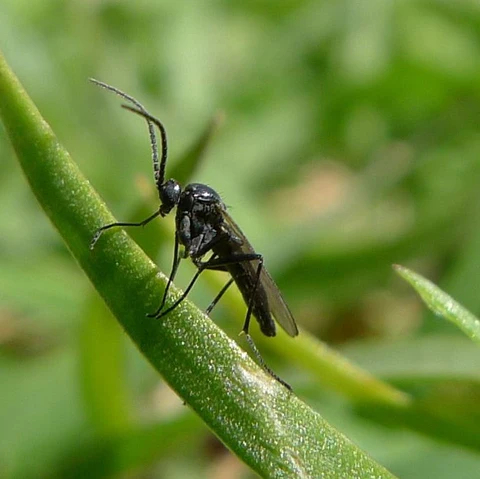
Gardeners across America are gearing up for the winter growing season in their greenhouses or scrambling to bring their potted plants indoors before the first frost hits. Unfortunately for these gardeners, the winter season also means that fungus gnats are ready to throw a baby shower. They’re using your plants as the venue, and they’re not going to stop with just one baby shower. Like most pests, fungus gnats breed quickly and can devastate your garden if left unchecked. So how do you deal with fungus gnats?
Fungus gnats have a reputation as winter pests, but they don’t exclusively operate in the winter. They’re active year-round, but fungus gnats have unusually high tolerance to cold for an insect. Some species even have antifreeze proteins, which allows the bug to stay alive and somewhat active throughout the winter, instead of remaining in an egg like other insect pests.
Thankfully, despite the fungus gnat’s high cold tolerance, fully mature members are not all that threatening. In fact, they’re largely passive. Adult fungus gnats are poor fliers. What limited flight they have is more analogous to extended, meandering hopping rather than the precise flight exhibited by a housefly. The adults cannot eat any part of your plant. In fact, adult fungus gnats cannot eat any solid food. They live out their 10-day lifespans on a liquid-only diet of water and plant nectar (if they can easily access it.)
However, adult female fungus gnats can lay over 300 eggs during their brief lifespan. And while the adults are nuisances, the larvae are actual pests to your plants. Fungus gnat larvae will eat through plant roots and leave plants highly susceptible to root rot. With their rapid breeding cycles, fungus gnats can quickly overrun a greenhouse if you aren’t paying attention.
Fungus gnat pest control happens in three steps:
- Prevent conditions favorable to fungus gnats from occurring.
- Kill off eggs and larvae.
- Kill off mature fungus gnats to prevent future egg lay.
Conditions Fungus Gnats Love
Soggy, overwatered soil is a fungus gnat’s favorite place to start a family. Eggs and larvae like to hang out in the first couple of inches of soil, so make sure that your topsoil stays dry between watering. To keep topsoil dry, try watering at the root of the plants. While you can go all out and use a drip irrigation system if you have a large grow operation, there are ways to water generic potted plants at the root. Check your pot. Does it have any holes in it along the bottom? If it does, place the pot in a large container. Water the container itself and watch as the water is sucked up through the holes in the bottom of your pot.
Eliminating Eggs and Larvae
You don’t want to search for eggs and larvae manually. These things are tiny and often buried under an inch of topsoil. Instead, track your pest control efforts by monitoring the adult population (more on this in the next section). Of course, it’s not unusual to see a fungus gnat eggs and larvae, though both are near microscopic. Eggs are tiny white dots while larvae have black heads, white-to-translucent bodies, and are about ¼ inch long when fully grown. If you see one, just know that many more are likely just below the initial topsoil layer.
To control egg and larvae populations, use a spray, such as the BONIDE® Captain Jack’s™ Neem Max or maintain a population of fungus gnat predators in your soil, such as beneficial nematodes.
Eliminating Mature Populations
Since adult fungus gnats aren’t a threat beyond their egg laying capabilities, using normal sticky paper is sufficient to control populations. Fungus gnats are very weak fliers, so making minimal contact with the adhesive is enough to immobilize the adult. Make sure you get yellow sticky paper—this color attracts the most fungus gnats. A bonus of using sticky paper is that you can monitor adult population levels over time. Once new adults stop getting stuck to the fly paper, you’re on the path towards wiping out your unwanted winter gardening guests.
ARBICO Organics was founded in 1979 in Arizona. Over 40 years later, ARBICO Organics continues to produce innovative means of natural biological pest control for a wide range of consumers. Their product line up ranges from environmentally friendly solutions to common garden pests to biological powerhouses used in professional agriculture and at racetracks.



Comment here